
The ocean has always tempted me. The waves moving like enormous hands stroking the shore making the "shhhh..."-sound, as if calling my name. And the rocks that brake the water, and the wind that blows my hair of my face. And the horizon that promises so much..

Galicia has it all for someone who's looking for such an experience. The GZ coast has it's extreme points of land, that you'd call the edge of the world if we lived about the 14 century. The most famouse ones are Fisterra (Finis Terrae) - the extreme west; and Cabo Ortegal - the extreme north.

Another Saturday tour was to the north. We took a bus ride along the peaks of the rocky coastline from the Atlantic ocean to the Cantabric sea. Lovely weather, blue bays, eucaliptus forrests on the hills around, wind farms and wild cows. And a fishermen town of Cariño(Tenderness) with a fish tin factory.
It was the day of blue.


























